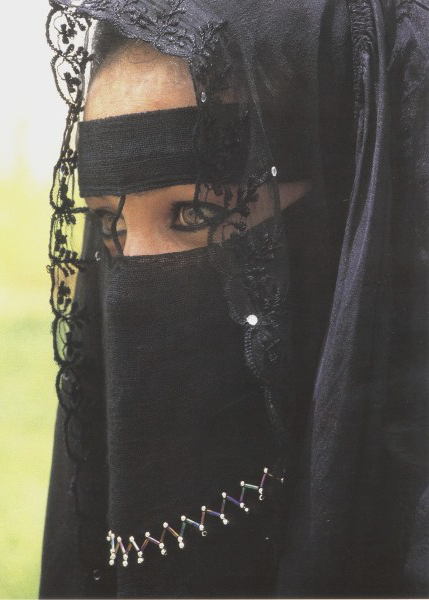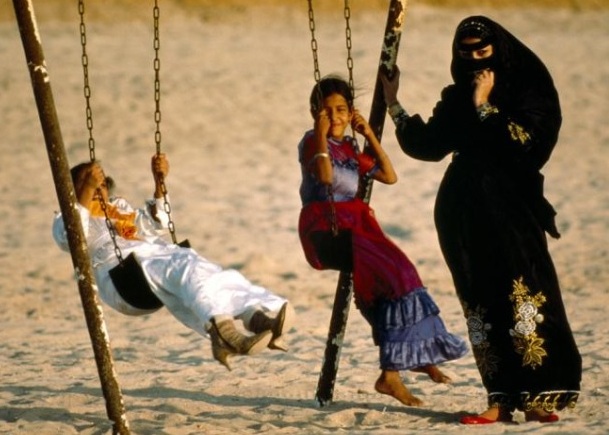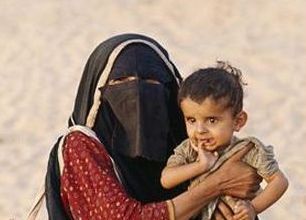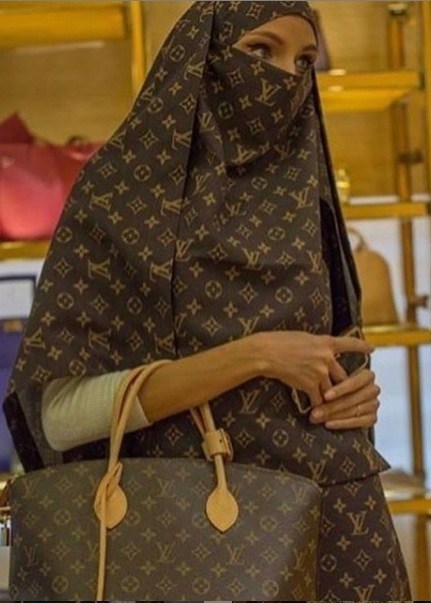




This is the third post in our series on veiling in the UAE. Find the first two posts here and here. In this post, we will look at al-baghrah or niqab Niqāb: (Arabic: face cover), cloth face veil or mask with two cutouts, holes or openings for the eyes. in more detail.

The name comes from baqarah meaning to slit open. Today’s al-baghrah, whether in its urban or Bedouin form, is a garment slit open at the position of the eyes. Note that the Bedouin face cover is also known by other names in different regions including al-burghu, al-maghrun, al-nughbah, al-qina. It is most commonly known today in the UAE as the al-niqab Niqāb: (Arabic: face cover), cloth face veil or mask with two cutouts, holes or openings for the eyes..
In the wider international community, the word niqab Niqāb: (Arabic: face cover), cloth face veil or mask with two cutouts, holes or openings for the eyes. is commonly used to refer to a garment that covers a Muslim woman’s face while leaving only the eyes exposed.
There is no literary or photographic evidence of the use of the al-baghrah in the UAE, both coastal and inland, before the late 1980s. The appearance of this form of face cover coincided with the decrease in the urban use of the traditional facemask, the burghu or batulah Baṭūlah: (Arabic), face mask covering the chin or slightly more, with varying eye cut-outs. Used by women in Bahrain, Emirates, Qatar, Oman, and southern Iran. More widely known in the Arab world as (burqa’) where the letter [qaf] in many Arab regions is pronounced [gah].. It seems likely that some women who felt uncomfortable to show their faces in public due to social upbringing, custom, newly learned religious practices, or a personal need to stay incognito, began to wear the al-baghrah.
This form of face cover was introduced to the UAE from Saudi Arabia during the late 1980s and was sold by a well-known UAE merchant. It came in only one simple style, but local manufacturers soon started introducing new and different styles.
“We used to place only one layer of fabric on our faces, wearing it on top of the burghu as a safeguard to ensure our features were concealed. As women began to interact more in public, many no longer sported the burghu, and so started the custom of placing a second layer, and sometimes a third layer on our faces, as an added measure to guarantee total coverage of our features. But it no longer allowed us to see much and was truly impractical. This, coupled with more frequent visits to Saudi Arabia for pilgrimage, introduced us to the present day niqab Niqāb: (Arabic: face cover), cloth face veil or mask with two cutouts, holes or openings for the eyes. form of face cover. Many find this to be a much more comfortable alternative as it disguises the women yet permits her to see her way. Of course, we call it both by its more common Saudi name, niqab Niqāb: (Arabic: face cover), cloth face veil or mask with two cutouts, holes or openings for the eyes., and by the local term baghrah as it reminds us of an earlier Bedouin form very similar in shape but much more ornate.”
Shaykha Shamah bint Muhammed bin Khalid Al Nahyan.
The UAE baghrah in its present urban form is an amalgamation of a contemporary version of the Islamic niqab Niqāb: (Arabic: face cover), cloth face veil or mask with two cutouts, holes or openings for the eyes. and the Bedouin facemask known throughout the Arab region. It is a fairly newly acquired custom, imported from neighbouring Saudi Arabia, and used only in public.

The baghrah is made of a rectangular double layer of fine black gauze Gauze: (English), very fine wire mesh transparent fabric of silk, linen, or cotton. that filters the dust. It is composed of upper and lower sections attached to each other at the position of the eyes. Its length can vary from just below the chin to chest level. The upper layer extends to the chin and only the bottom layer extends lower. Both layers are edged with a basic trim. It also has a third smaller top section similar to the isabah which was a headband made from a folded rectangular cloth placed around the forehead and tied at the back to hold a longer veil in place, popular during the Abbasid period. The larger lower rectangular section is a shorter form of the Abbasid, Mamluk and Ottoman khimar Khimār: a long piece of cloth used to cover a woman's head, draped to the elbows and pinned under the chin, leaving the face exposed. A type of hijab..

Al-jabhah – the upper part that covers the eyebrows. The stiff forehead piece is usually lined with the same material and is 2-5 cm wide and sometimes extends round to tie at the back securing the whole mask to the face.
Al-uruwah – sometimes pronounced irawi or arawi, are fabric laces that act like the ghitan used to fasten the burghu. It is used to tie the baghrah to the face when the al-jabhah only extends across the face. It used to be tied in a knot behind the head, but nowadays they are secured using Velcro™.
Al-uyun – are the openings for the eyes which were originally very narrow so even the eyelids are covered to protect them from tanning. Pale skin was sought after in the Arab world as a whole.
Al-tabjah – meaning layer, is the main fabric component that covers the cheeks and extends to cover the chin or further to cover the top of the chest and is wide enough to extend from ear to ear. Since cotton gauze Gauze: (English), very fine wire mesh transparent fabric of silk, linen, or cotton. is transparent, layers of the fabric are used to ensure coverage of the face. In general, a shorter or folded layer is attached over the first layer and extends from below the eyes to the chin area. This is known as igfah or thenyah, meaning ‘fold’.
Al-binqah – is the cotton lace that attaches the upper al-jabhah to the lower part of the baghrah down the nose ridge.

The general shape of the baghrah has not changed much during its relative short modern history, though different types of black fabrics of varying densities and textures have made their appearance. It has, however, attained a few practical modern novelties such as Velcro™ fasteners and iron-on stiffening fabric in the al-jabhah.
In addition, subtle decorative embroidery and iron-on embellishments have been introduced to highlight areas such as the eye-opening, the chin line or the lower edge of the fabric. As a design element, extra layers of up to four folds, extending to the middle of the chest are sometimes added and are referred to by different names:

Future
The connotations attached to the baghrah have changed from ethnic Bedouin to a more Islamic religious expression. Its use has spread to many Arab Muslim countries and is considered to symbolise a number of conflicting viewpoints.
Some consider it to be the present-day Islamic hijab Ḥijab: (Arabic: to cover or conceal, pl: aḥjibah), refers to any article of dress or otherwise, that serves to conceal. In colloquial Egyptian, refers to a large diamond-shaped motif on the torso of (tūr_bi_tallī) wedding dress, or dance robe. Also applied to large central medallion on shawls and scarves., others disagree. Many westerners regard it as an element that confines and oppresses women, but many Arab women find it helps them achieve freedom of private movement in public. As author Lila Abu-Lughod comments in her book Do Muslim Women Need Saving, many women, especially those from the upper social class, see the baghrah or niqab Niqāb: (Arabic: face cover), cloth face veil or mask with two cutouts, holes or openings for the eyes. as a ‘portable seclusion’ and regards it as more of a culture and social class related garment, rather than a religious one.
Many Arab women consider it as a symbol of defiance towards western values and injustices inflicted upon the Muslim world. In this context, it is likely that it will continue to be worn by women, not only in the UAE but throughout the Arab and Muslim society around the world.